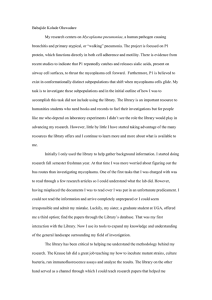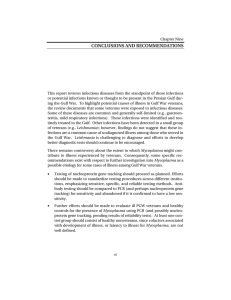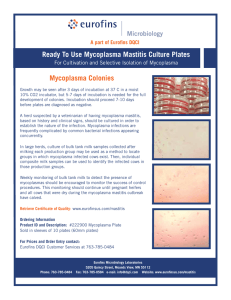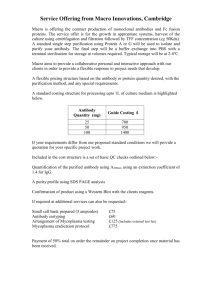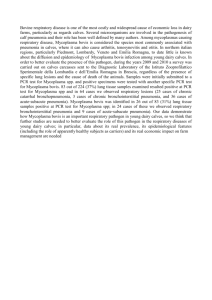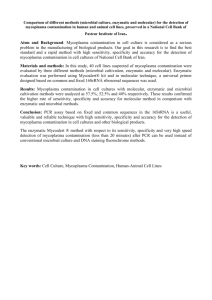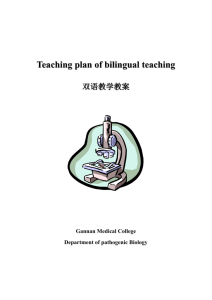MYCOPLASMA
advertisement
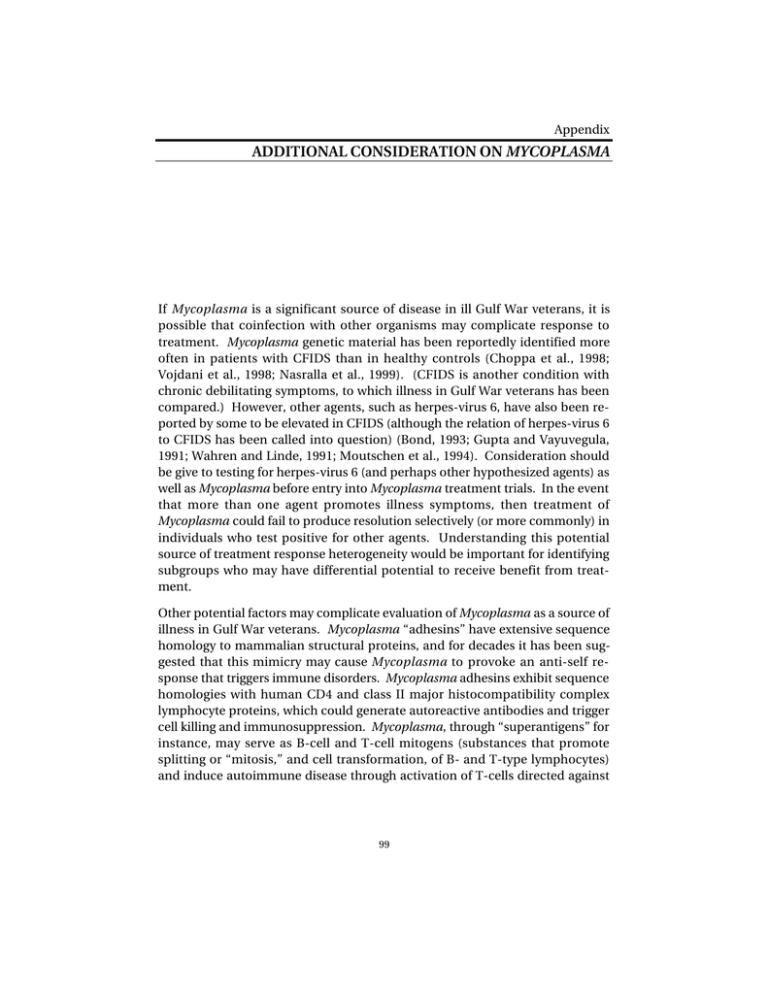
Appendix ADDITIONAL CONSIDERATION ON MYCOPLASMA If Mycoplasma is a significant source of disease in ill Gulf War veterans, it is possible that coinfection with other organisms may complicate response to treatment. Mycoplasma genetic material has been reportedly identified more often in patients with CFIDS than in healthy controls (Choppa et al., 1998; Vojdani et al., 1998; Nasralla et al., 1999). (CFIDS is another condition with chronic debilitating symptoms, to which illness in Gulf War veterans has been compared.) However, other agents, such as herpes-virus 6, have also been reported by some to be elevated in CFIDS (although the relation of herpes-virus 6 to CFIDS has been called into question) (Bond, 1993; Gupta and Vayuvegula, 1991; Wahren and Linde, 1991; Moutschen et al., 1994). Consideration should be give to testing for herpes-virus 6 (and perhaps other hypothesized agents) as well as Mycoplasma before entry into Mycoplasma treatment trials. In the event that more than one agent promotes illness symptoms, then treatment of Mycoplasma could fail to produce resolution selectively (or more commonly) in individuals who test positive for other agents. Understanding this potential source of treatment response heterogeneity would be important for identifying subgroups who may have differential potential to receive benefit from treatment. Other potential factors may complicate evaluation of Mycoplasma as a source of illness in Gulf War veterans. Mycoplasma “adhesins” have extensive sequence homology to mammalian structural proteins, and for decades it has been suggested that this mimicry may cause Mycoplasma to provoke an anti-self response that triggers immune disorders. Mycoplasma adhesins exhibit sequence homologies with human CD4 and class II major histocompatibility complex lymphocyte proteins, which could generate autoreactive antibodies and trigger cell killing and immunosuppression. Mycoplasma, through “superantigens” for instance, may serve as B-cell and T-cell mitogens (substances that promote splitting or “mitosis,” and cell transformation, of B- and T-type lymphocytes) and induce autoimmune disease through activation of T-cells directed against 99 100 Infectious Diseases self, or polyclonal B-cells (Joseph, 1997).1 For instance, Mycoplasma arthritidis superantigen appears to induce a lymphokine profile that favors activation of B-cell function, which may heighten the risk of triggering autoimmune disease in rodents.2 The multiorgan protean manifestations of mycoplasmal infections in humans are considered by some to be consistent with the pathogenesis of autoimmunity (Joseph, 1997). If a bacteria-mediated autoimmune disorder is provoked, then disease could persist after the inciting infection abates or is eradicated. Supporting this possibility are results of studies producing experimental arthritis in rodents by introducing Mycoplasma. Organisms are readily cultured from the joints early but later become increasingly difficult to recover even in the presence of severe active inflammation.3 Moreover, in the case of rheumatoid arthritis, treatment with antibiotics appears to be more effective early in the course of disease.4 It would be instructive to determine whether isolation of Mycoplasma differs early and late in the course of illness in Gulf War veterans (although early disease may be rare almost a decade after the putative exposure). If Mycoplasma is a cause of illness in PGW veterans (and perhaps also if Mycoplasma is not), then response to treatment may be less successful with increasing time from onset of disease. If there is merit to the hypothesis that cytokine shifts favoring a Th2 cytokine profile occur as a result of Gulf War exposures, as has been postulated, and if this results in heightened susceptibility to intracellular infections including Mycoplasma infections, then acquisition of Mycoplasma infection could have occurred at a higher rate in Gulf War veterans than in controls long after the cytokine-shifting “exposures” occurred in the Gulf War. By this hypothesis, acquisition of the Mycoplasma infection could occur after departure from the Gulf or from the service, although susceptibility to this infection might be conditioned by exposures in the Gulf War. Although it must be emphasized that this is entirely speculative, in this scenario, it is not necessary to postulate vaccine contamination or any other means of increased Mycoplasma exposure in the Gulf War. Rather, similar Mycoplasma exposure (perhaps even associated with similar antibody responses) may be more likely to lead to Mycoplasma colonization or infection, and perhaps to “disease” in Gulf War veterans than in controls. Moreover, it is possible that Th2 cytokine shifts may be associated with illness that has nothing to do ______________ 1L. Millett, letter to Garth Nicolson (1996); K. Roberts, letter to Garth Nicolson (1996). 2R. Synder, letter to Garth Nicolson (1996). 3L. Millett, letter to Garth Nicolson (1996); R. Toth, letter to Garth Nicolson (1996). 4J. Baseman, personal communication to Beatrice Golomb (1997). Additional Consideration on Mycoplasma 101 with Mycoplasma, but occurs through distinct mechanisms (infectious or otherwise). This hypothesis is an area for possible research.5 ______________ 5Detectable Mycoplasma could merely represent an “innocent bystander” consequence of the cytokine shift. (This hypothesis predicts that Mycoplasma-negative, ill Gulf War veterans with Th2 cytokine shifts, presumably from other causes, would acquire future Mycoplasma infection at a higher rate than controls without such cytokine shifts, and that the rate of development of illness in Th2shifted Gulf War veterans who are not currently ill would be independent of conversion to the Mycoplasma -positive state.)
